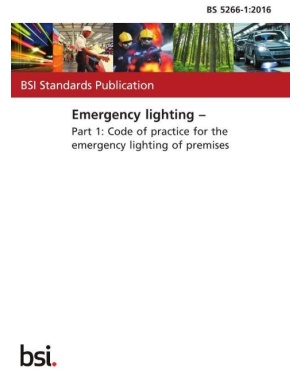- Free standard delivery
- Best price guaranteed
- Fast same-day shipping
- Over 20 years experience
- Family-run business
BS 5266-1:2016
| ISBN | 9780580919831 |
|---|---|
| Publication Status | Current |
| Publication Date | 01/06/2016 |
| Format (Paperback, Hardback etc) | A4 |
| Total Pages | 74 |
| Brand / Publisher | BSI |
| Publisher | BSI |
BS 5266-1:2016 Code of practice for the emergency escape lighting of premises
Overview
This standard gives detailed guidance on the application and practice of emergency lighting. The standard's recommendations have been drawn up to encourage uniformity of application, based on providing adequate safety to people in the event that normal lighting is interrupted.
The standard aims to promote a wider understanding of the different types of emergency lighting system that can be used and give guidance on how different systems can be correctly applied to different categories of premises with varied requirements.
Who is the standard for?
The standard has been written for two audiences.
1. Lighting engineers and electrical contractors who need to protect building occupants from the hazards identified by risk assessments. The standard gives guidance on both new and existing installations to meet current requirements.
2. The standard is also designed to give confidence to premises' owners, landlords and employers that they are meeting their legal requirements regarding emergency lighting. As such is it written for responsible persons for the following types of premises:
* premises used as sleeping accommodation which includes hospitals, care homes, hotels, guest houses, certain clubs, colleges and boarding schools;
* non-residential premises used for treatment or care such as special schools, clinics and similar premises;
* non-residential premises used for recreation such as theatres, cinemas, concert halls, exhibition halls, sports halls, public houses and restaurants;
* non-residential premises used for teaching, training and research and offices. This includes schools, colleges, technical institutes and laboratories;
* non-residential public premises such town halls, libraries, shops, shopping malls, art galleries and museums;
* sports stadia;
* covered car parks;
* industrial premises used for manufacture, processing or storage of products such as factories, workshops, warehouses and similar establishments;
* multiple use of premises.
The standard also applies to:
* common access routes within blocks of flats or maisonettes.
What does the standard cover?
This part of BS 5266 gives recommendations and guidance on the factors that need to be considered in the design, installation and wiring of electrical emergency escape lighting systems to provide the lighting performance needed for safe movement of people in the event of the supply to normal lighting failing.
It also gives recommendations for lighting in areas with fixed seating.
How has the standard changed since the 2011 version was published?
This revision aligns with the European emergency lighting luminous requirement specification standard, BS EN 1838:2013, and extends the scope of the existing standard by:
1. Providing guidance on the application and practice of emergency lighting. It highlights that risk assessments are needed for all premises. Also that the risk assessment identifies the risk to people entering a premises and that the measures the assessor is required to take include the provision of safe means of escape taking into account the needs of people with disabilities including visual impairment.
2. Covering high risk task lighting to provide illumination for the safety of people involved in potentially dangerous processes or situations, to enable proper shut-down procedures for the safety of the operator and other occupants of the premises.
3. Providing guidance on the implementation of requirements and solutions, particularly on suitability and energy usage.
4. Providing guidance on election and planning the scheme of required equipment.
5. Including reference to development of new system types.
6. Including guidance on illumination of external 'open balcony' approaches to flats/maisonettes within blocks.
7. Including guidance on illumination of swimming areas within swimming pools.
8. Adding guidance on the installation process, testing and commissioning.





